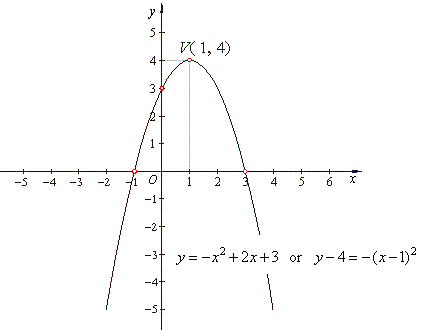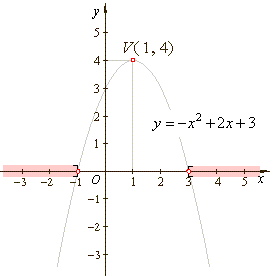 |
| We
can deal with the given quadratic using the property of the
polynomial explored under the title, |
| '
Source
or original polynomial function '. Thus, |
| 1)
calculate the coordinates of translations of the quadratic
y
=
f (x) =
-
x2
+ 2x
+
3 |

|
| 2)
To
get the source quadratic function, plug the coordinates
of translations (with changed signs) |
|
into the general form
of the quadratic, i.e., |
| y
+ y0
= a2(x
+ x0)2
+ a1(x
+ x0)
+ a0
=> y
+ 4
= -
(x
+ 1)2
+ 2(x
+ 1)
+
3 |
|
y
=
-
x2
the source quadratic function |
| 3)
Inversely, by plugging the coordinates of translations into the source quadratic function |
| y
- y0
= a2(x
- x0)2
=> y
- 4
= -
(x -
1)2
|
|
obtained is given quadratic in general form
y
=
-
x2
+ 2x
+
3. |
|
|
|
Quadratic Inequalities
|
| To solve a quadratic inequality we can examine the sign of the
equivalent quadratic function. |
| The
x-intercepts
or roots are the points where a quadratic function changes the sign. The
x-intercepts determine
the three intervals on the x-axis in which the function is above or
under the x-axis, that is, where the function is positive or negative. |
|
| Example:
Solve the inequality
-
x2
+ 2x
+
3 ≤
0. |
| Solution:
Solve the quadratic
equation ax2
+ bx
+
c
= 0
to get the boundary points. |
| The zeroes
or roots of equivalent function (see the graph
below) are the endpoints of the intervals and are included in the solution. |
|
The turning point V(x0,
y0), |
 |
|
The roots, -
x2
+ 2x
+
3 =
0 |
 |
|
 |
| Solution: |
 |
|
|
|
|
|
|
|
|
|
|
|
|
|
|
|
| Intermediate
algebra contents |
|
 |
|
| Copyright
© 2004 - 2020, Nabla Ltd. All rights reserved. |